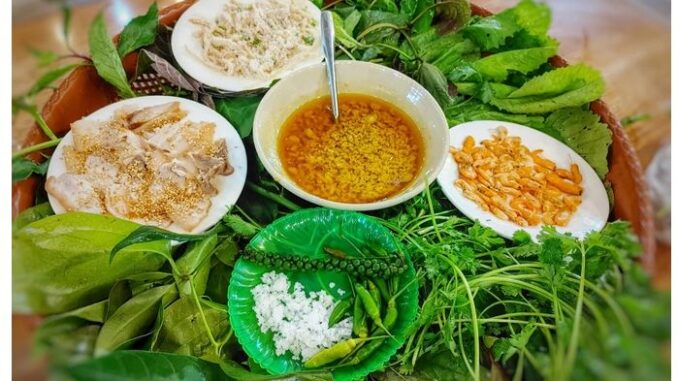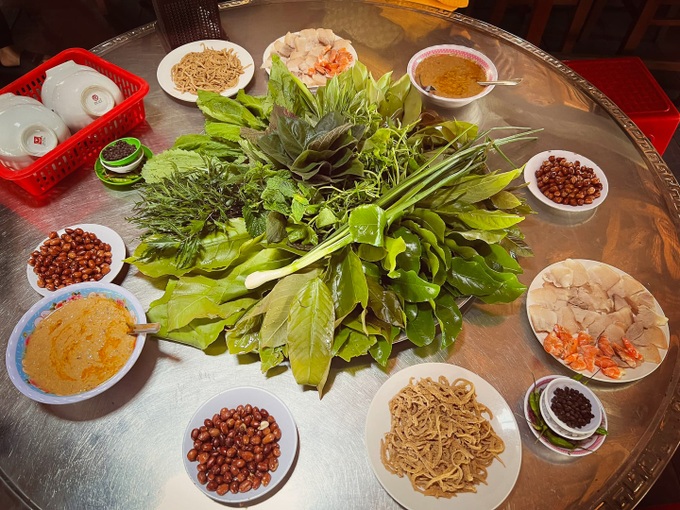
In addition to bamboo shoots, red vermicelli, beef with a sun, fish from the Serepok river, … Kon Tum land also has a specialty that visitors cannot ignore, which is leaf salad.
Leaf salad was once recognized as the top 10 Vietnamese specialties with Asian culinary value. As the name suggests, this dish consists of the main ingredient… leaves. Kon Tum people use 30 – 60 different types of leaves, including 3 main groups.
The first is the easy-to-find, easy-to-grow leaves in the home garden such as vegetables, perilla, mint, cloves, marjoram, fig leaves, apricot leaves, green onions, centella asiatica, lettuce, basil .. .
Next are the leaves that appear less in the meal such as guava leaves, mango leaves, bunches of intestines, five houseplants… Finally, there are the typical forest leaves of the Central Highlands, usually only local people. known as brocade leaves, red-ranked branches, bear bile, bamboo leaves, great compassion, lost fairy, forest tamarind, Xam bone, huts,…

“The first time I enjoyed the leaf salad in Kon Tum city, I could not recognize the strange leaves on the table. When the restaurant staff introduced it, my friends and I were “surprised” because the names were too good. strange,” said Quoc Hung (HCMC), a customer.
According to the owner of a restaurant on Tran Cao Van street, Kon Tum city, the restaurants here serve leaf salad all year round. However, depending on the season, weather and climate, the types of salad leaves change. The rainy season (late April to November) is the time when this dish is most diverse, can combine 50-60 types of leaves.
According to research, this dish has been around for a long time. In the past, local people went to the forest to clear their fields for farming, often picking leaves from the forest to eat at lunchtime, and then bringing them home for dinner. Later, they combine the leaves with side dishes such as shrimp and meat to create a unique dish that invites guests from far away.

The leaves are harvested by locals early in the morning. Must be a proficient jungler to be able to correctly distinguish the leaves, avoiding poisonous and dangerous ones for people to eat. Some types are difficult to find, requiring people with a lot of experience, remembering locations, ready to cross the forest, creep into large bushes or climb craggy cliffs.
Among the green “leaf trays” are side dishes such as pork belly, dried shrimp and pork skin.
Bacon is only selected pieces with both lean and fat so as not to be too tired or too dry, boiled and then sliced thinly. Ground shrimp are cut off, cleaned and then roasted fragrantly, the outside is dry but the inside is still soft and succulent. The pork skin is also boiled, sliced into thin strips like spring rolls, then mixed with hearing and some accompanying spices. Next to it is a plate of granulated salt, green pepper and chili.

The most special and amazing thing about this leaf salad is the dipping sauce. The sauce is made from a mixture of fermented glutinous rice, brewed with dried shrimp and pork belly, just like a bowl of thick porridge with turmeric yellow color.
The chef prepares a pan of hot oil on the stove, fry the onions until fragrant, then add the above mixture, add batches, satay, spices and stir well with low heat. There is an “implicit rule” that the chef must not taste, but must rely on the aroma to know if the sauce has reached the level of deliciousness or not.
Side dishes and sauce bowls are cleverly arranged between the tray of leaves. When eating, diners have to slowly roll each layer of leaves. First, you use a large leaf like apricot leaf, fig leaf, roll it into a small funnel, then choose 5-7 types of leaves as you like, add slices of boiled meat, pork skin, and roasted shrimp.
Then, use a spoon to add a little dipping sauce, add chili or green pepper and then put it in your mouth to enjoy. For each book, diners can choose different types of leaves to enjoy a variety of flavors.

The rich taste of shrimp and meat is harmoniously combined with the leaves of Bui Bui, acrid, slightly sour, adding a little pungent green chili, pepper and the greasy taste of the dipping sauce… making diners enjoy . This dish is cool, not boring. In addition, the leaves also have medicinal properties, which have the effect of clearing body heat and curing diseases.
This dish is quite popular in restaurants, homestays or resorts in Kon Tum. Each serving of leaf salad is served full, for about 3-4 people to enjoy with prices ranging from 100,000 – 150,000 VND.
($1=24,000 VND)
Photo: Internet (Vinlove.net)
